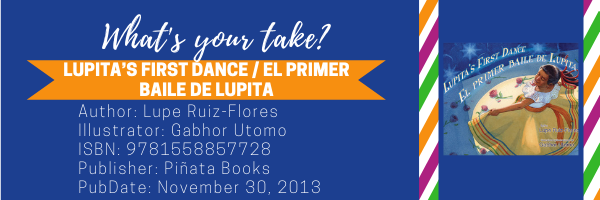By María V. Acevedo-Aquino and Myriam Jimena Guerra, Texas A&M University-San Antonio, San Antonio, TX
Myriam Jimena and María present this week a fourth book authored and/or illustrated by Lupe Ruiz-Flores and Carolyn Dee Flores. They invite readers to reflect upon their experiences with music and dance: Have you experienced music and dance as tools or parts of your identities? Or both?
MYRIAM: This beautiful story narrates how Lupita overcame, perhaps her first serious problem in life, with courage and bravery. Lupita, a first grader, has been practicing and practicing a traditional Mexican folk dance: La Raspa. Just moments before the Children’s Day presentation at school, she discovered that her dance partner, Ernesto, sprained her ankle and has zero possibilities of joining her at the dance. Although Lupita was confused and scared, while wearing her special dance dress, she decided to go on stage and dance on her own. As expected the audience is surprised by the unique situation and some make fun of her. However, her mother signals that she ought to continue dancing. Thus, providing the necessary encouragement for Lupita to do her school performance.
MARÍA: This book is my first experience with La Raspa. I enjoyed watching YouTube videos to get a more realistic image of the dance, especially since I associate the word “raspa” with Mexican raspas or raspados (snow cones). I feel like Estela in Let’s Salsa/Bailemos Salsa, when the only salsa she knew was the chips with salsa. Lupita’s story took me back to my elementary school. Every year students performed at least three times for the entire school songs and dances representative of Puerto Rican folklore. Every year there were a few children who danced by themselves like Lupita. The only difference was that their teachers expected them to dance with or without their partners. The teachers at my elementary school always thought that the children could dance or sing, even when some decided to watch from the audience. I wonder if Lupita would have felt more supported if the teacher would have said something like: I would love to see you dance, you can do it. However, I understand if you don’t want to dance without your partner.
MYRIAM: Lupita’s encouragement and risk-taking attitude will encourage young children to persevere in attaining their own goals, although facing difficult circumstances. Often, children’s realities are filled with choices and decisions that they have to make on their own. If exposed to these opportunities, they will develop problem-solving skills and the capacity to learn how to confront new challenges. Lupita’s attitude is valuable, because she faces fear at the beginning and she could have run away and decided not to perform during her first dance. Instead, she confronted her fears and solved her difficult situation with a positive attitude and on her own terms.
MARÍA: Yes, Jimena, Lupita’s strategies and dispositions to confront challenges at her young age are outstanding. I also noticed that she also utilized her imagination to create a secure and encouraging environment to take risks. At the end of the story, Lupita describes to her parents the spotlight and the flowers she received from the audience. These elements are even present in the illustrations. However, when dad responds: “you have such a great imagination!”, the reader realizes it was all in Lupita’s head. Her hopeful mindset and creativity allowed her to see possibilities. Imagination is many times taken for granted in schools or reduced to fit prescribed curricula. This story can support children, especially during 2020 to find the strength within themselves, and to use their imaginations to imagine a stronger version of themselves.
Title: Lupita’s First Dance/El primer baile de Lupita
Author: Lupe Ruiz-Flores
Illustrator: Gabhor Utomo
ISBN: 978-1-55885-772-8
Publisher: Piñata Books
PubDate: November 30, 2013
Throughout September 2020, Myriam Jimena and María explore the contributions of two authors of children’s literature living in San Antonio, TX: Lupe Ruiz-Flores and Carolyn Dee Flores (mother and daughter). Check back each Wednesday to follow the conversation!

